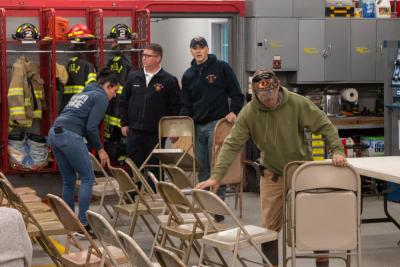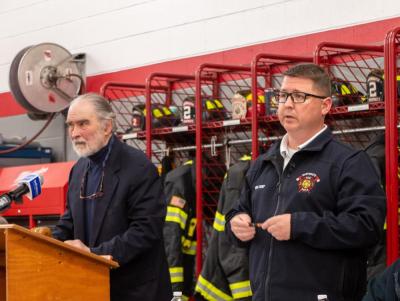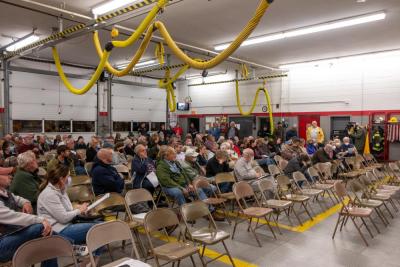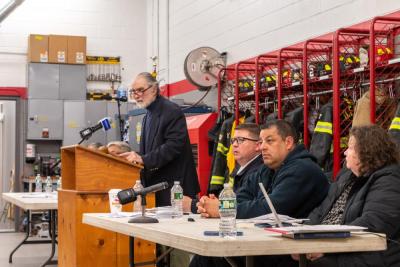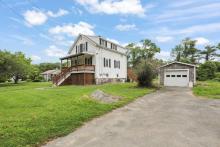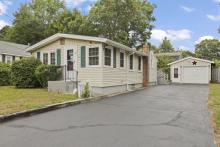Fire District 2 voters reject proposal for new full-time firefighters
Dartmouth’s Fire District No. 2 saw a record turnout at its annual meeting on Monday night, May 9 with voters filling the Russells Mills village station to consider large-scale changes to the department’s structure that were ultimately rejected.
“It’s historic — we’ve never had this many people show up for a district meeting that I know of,” said District 2 interim Fire Chief Greg Edgcomb, explaining that the attendance was likely motivated by the weight of the proposals. “I’m proposing some pretty significant changes to the department.”
At the start of the meeting, 177 district voters were present.
The primary issue in question was whether to fund the hiring of six full-time firefighters to a fire department that currently only employs two firefighters full-time, plus a fire chief, and about 18 on-call firefighters.
Edgcomb said that the new hires would replace many of the on-call firefighters while ensuring that the department could be staffed at all times, instead of only 40 hours a week, as is currently the case.
“Every set of gear here works a full-time job in addition to being a firefighter,” he said, gesturing to the protective equipment stored methodically in cubbies around the room. “If this were to pass, it would change the way the department was structured because we wouldn’t need those on-call firefighters as much.”
He asserted that such a change would decrease the department’s response time considerably, especially during the work day — when nearly every on-call firefighter is busy with their full-time jobs — and when the town’s ambulance service is otherwise occupied.
“When the ambulance is not here it can take 10 to 15 minutes to get one from somewhere else,” he said. “We can solve those problems with emergency responders if the ambulance isn’t here.”
However, the change would have come with a large increase in the district’s budget.
The new positions would have cost $251,200 in the budget for fiscal year 2023 with a savings of $45,000 coming from a reduction in the budget for call firefighters for a total increase of $206,200.
However, the $251,200 would only fund the new hires’ salaries for six months, accounting for delays in recruitment and training. Once the department was at full staff, the cost of the new firefighters would have risen to over $500,000 per year plus funding for a retirement program.
Edgcomb tried to temper concerns about ballooning costs to the taxpayer by pointing out that funding for the retirement program would cost about as much as the department’s annual payments to a ten-year construction and renovation loan that will be fully paid off after this year.
He added that having 24/7 fire station coverage would eventually reduce the cost of homeowner’s insurance in the area, potentially saving some taxpayers money in the long run.
“So for me the value is there,” Edgcomb said.
The proposal was recommended 2-0 by the Fire District 2 Prudential Committee. However, the committee was shaken up in its election two weeks ago and the new committee members, Bob Bouley and Bill Coutu, spoke out against hiring the new full-timers.
The dissenting committee members said the onus should be on the town to increase its ambulance coverage, not on District 2 to make up for the shortfall.
Ultimately, the district’s voters elected to table the additions indefinitely, allowing the Prudential Committee to return to the issue in the future.
Voters also spent significant time discussing Article 3 of the district warrant, which appropriated $115,000 for the fire chief’s salary.
The prudential committee told the voters that while the salary was higher than the $97,954 that was paid to the previous fire chief last year, the increase was necessary to recruit Edgcomb to the position.
“I know if it’s not approved, we won’t have [Edgcomb] as chief,” said prudential committee member Ralph Medeiros, explaining that Edgcomb would already be taking a paycut to accept the job in his hometown. “I don’t mind paying him the extra dough because I’ve seen the difference in his management style. We can cut corners here but you have to pay for quality people.”
Ultimately, the $115,000 salary was approved after an amendment to lower it to $100,000 was rejected by all but about 15 voters.
The tax levy for the district’s budget that was approved by the voters totaled $891,614, a 1.9% decrease from last year’s levy of $908,691. An additional $45,000 was appropriated from the district’s free cash — surplus funds from previous years — for repairs and new gym equipment.
About 10,000 residents live in District No. 2, which is sandwiched by Horseneck and Division roads on the west, and Russells Mills and Potomska roads on the east. The district extends to the Buzzards Bay coast on the southern end, and reaches about halfway up Chase and Lucy Little roads going north.




